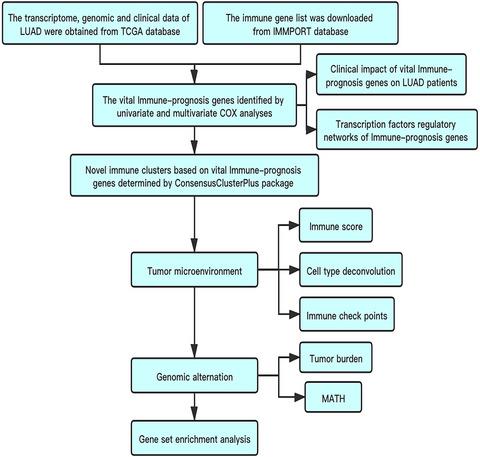当前位置:
X-MOL 学术
›
FEBS Open Bio
›
论文详情
Our official English website, www.x-mol.net, welcomes your
feedback! (Note: you will need to create a separate account there.)
Novel immune subtypes of lung adenocarcinoma identified through bioinformatic analysis.
FEBS Open Bio ( IF 2.8 ) Pub Date : 2020-08-26 , DOI: 10.1002/2211-5463.12934 Fang-Lu Qin 1 , Zhan-Yu Xu 1 , Li-Qiang Yuan 1 , Wen-Jie Chen 1 , Jiang-Bo Wei 1 , Yu Sun 1 , Shi-Kang Li 1
FEBS Open Bio ( IF 2.8 ) Pub Date : 2020-08-26 , DOI: 10.1002/2211-5463.12934 Fang-Lu Qin 1 , Zhan-Yu Xu 1 , Li-Qiang Yuan 1 , Wen-Jie Chen 1 , Jiang-Bo Wei 1 , Yu Sun 1 , Shi-Kang Li 1
Affiliation

|
The magnitude of the immune response is closely associated with clinical outcome in patients with cancer. However, finding potential therapeutic targets for lung cancer in the immune system remains challenging. Here, we constructed a vital immune‐prognosis genes (VIPGs) based cluster of lung adenocarcinoma (LUAD) from IMMPORT databases and The Cancer Genome Atlas. A transcription factor regulatory network for the VIPGs was also established. The tumor microenvironment of LUAD was analyzed using the ESTIMATE (Estimation of STromal and Immune cells in MAlignant Tumor tissues using Expression data) algorithm and single‐sample Gene Set Enrichment Analysis. The immune checkpoints and genomic alterations were explored in the different immune clusters. We identified 15 VIPGs for patients with LUAD and clustered the patients into low‐immunity and high‐immunity subtypes. The immune score, stromal score and ESTIMATE score were significantly higher in the high‐immunity subtype, whereas tumor purity was higher in the low‐immunity subtype. In addition, the immune checkpoints cytotoxic T lymphocyte associate protein‐4(CTLA4), programmed cell death protein‐1 and programmed death‐ligand were elevated in the low‐immunity subtype. The genomic results also showed that the tumor mutation burden was higher in the high‐immunity subtype. Finally, Gene Set Enrichment Analysis showed that several immune‐related gene sets, including interleukin‐2/STAT5 signaling, inflammatory response, interleukin‐6/Janus kinase(JAK)/signal transducer and activator of transcription 3 (STAT3) signaling, interferon‐gamma response and allograft rejection, were elevated in the high‐immunity subtype. Finally, high‐immunity patients exhibited greater overall and disease‐specific survival outcome compared with low‐immunity patients (log rank P = 0.013 and P = 0.0097). Altogether, here we have identified 15 immune‐prognosis genes and a potential immune subtype for patients with LUAD, which may provide new insights into the prognosis and treatment of LUAD.
中文翻译:

通过生物信息学分析鉴定肺腺癌的新型免疫亚型。
免疫反应的强度与癌症患者的临床结果密切相关。然而,在免疫系统中寻找肺癌的潜在治疗靶点仍然具有挑战性。在这里,我们从 IMMPORT 数据库和癌症基因组图谱构建了一个基于重要免疫预后基因(VIPG)的肺腺癌(LUAD)簇。还建立了 VIPG 的转录因子调控网络。使用 ESTIMATE(使用表达数据估计 MAlignant 肿瘤组织中的基质细胞和免疫细胞)算法和单样本基因集富集分析来分析 LUAD 的肿瘤微环境。在不同的免疫簇中探索了免疫检查点和基因组改变。我们为 LUAD 患者确定了 15 个 VIPG,并将患者分为低免疫和高免疫亚型。高免疫亚型的免疫评分、基质评分和 ESTIMATE 评分显着较高,而低免疫亚型的肿瘤纯度较高。此外,免疫检查点细胞毒性 T 淋巴细胞相关蛋白 4(CTLA4)、程序性细胞死亡蛋白 1 和程序性死亡配体在低免疫亚型中升高。基因组结果还表明,高免疫亚型的肿瘤突变负荷更高。最后,基因集富集分析显示几个免疫相关基因集,包括白细胞介素 2/STAT5 信号、炎症反应、白细胞介素 6/Janus 激酶 (JAK)/信号转导和转录激活因子 3 (STAT3) 信号,干扰素-γ 反应和同种异体移植排斥在高免疫亚型中升高。最后,与低免疫力患者相比,高免疫力患者表现出更高的总体和疾病特异性生存结果(log rankP = 0.013 和P = 0.0097)。总之,在这里我们已经确定了 15 个免疫预后基因和 LUAD 患者的潜在免疫亚型,这可能为 LUAD 的预后和治疗提供新的见解。
更新日期:2020-08-26
中文翻译:

通过生物信息学分析鉴定肺腺癌的新型免疫亚型。
免疫反应的强度与癌症患者的临床结果密切相关。然而,在免疫系统中寻找肺癌的潜在治疗靶点仍然具有挑战性。在这里,我们从 IMMPORT 数据库和癌症基因组图谱构建了一个基于重要免疫预后基因(VIPG)的肺腺癌(LUAD)簇。还建立了 VIPG 的转录因子调控网络。使用 ESTIMATE(使用表达数据估计 MAlignant 肿瘤组织中的基质细胞和免疫细胞)算法和单样本基因集富集分析来分析 LUAD 的肿瘤微环境。在不同的免疫簇中探索了免疫检查点和基因组改变。我们为 LUAD 患者确定了 15 个 VIPG,并将患者分为低免疫和高免疫亚型。高免疫亚型的免疫评分、基质评分和 ESTIMATE 评分显着较高,而低免疫亚型的肿瘤纯度较高。此外,免疫检查点细胞毒性 T 淋巴细胞相关蛋白 4(CTLA4)、程序性细胞死亡蛋白 1 和程序性死亡配体在低免疫亚型中升高。基因组结果还表明,高免疫亚型的肿瘤突变负荷更高。最后,基因集富集分析显示几个免疫相关基因集,包括白细胞介素 2/STAT5 信号、炎症反应、白细胞介素 6/Janus 激酶 (JAK)/信号转导和转录激活因子 3 (STAT3) 信号,干扰素-γ 反应和同种异体移植排斥在高免疫亚型中升高。最后,与低免疫力患者相比,高免疫力患者表现出更高的总体和疾病特异性生存结果(log rankP = 0.013 和P = 0.0097)。总之,在这里我们已经确定了 15 个免疫预后基因和 LUAD 患者的潜在免疫亚型,这可能为 LUAD 的预后和治疗提供新的见解。











































 京公网安备 11010802027423号
京公网安备 11010802027423号